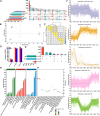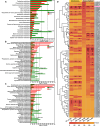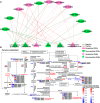Integrated transcriptomic and metabolomic analysis reveals stage-associated molecular profiles in Ophiocordyceps sinensis
- PMID: 40836216
- PMCID: PMC12366412
- DOI: 10.1186/s12864-025-11869-3
Integrated transcriptomic and metabolomic analysis reveals stage-associated molecular profiles in Ophiocordyceps sinensis
Abstract
Ophiocordyceps sinensis is globally recognized for its exceptional nutritional and medicinal properties. Variations in the edible qualities and tonic values of O. sinensis at different harvesting stages remain poorly understood in terms of compositional changes and regulatory mechanisms. Utilizing UPLC-MS/MS and transcriptome sequencing (RNA-seq), this study unveiled discrepancies in metabolite accumulation and gene expression of O. sinensis across various harvesting stages. Metabolomics analysis identified 596 differentially accumulated metabolites (DAMs), primarily enriched in amino acid-related metabolic pathways such as tyrosine, tryptophan, cysteine, and methionine metabolism. The up accumulation of organic acids and derivatives with delayed harvesting led to distinct abundances and compositions of amino acids, peptides, analogs, and fatty acids and conjugates, ultimately influencing the quality of O. sinensis. Transcriptomic analysis revealed 2550 differentially expressed genes (DEGs) at different harvesting stages, with KEGG-based enrichment analysis highlighting their involvement in amino acid-related activities like tyrosine metabolism and fatty acid degradation. The upregulation of these DEGs in amino acid-related pathways presents a promising target for studying O. sinensis quality. Integrative metabolomic and transcriptomic analyses indicated potential roles for DDC (G6O67_000335), TYR (G6O67_005660), AOC (G6O67_005457), and fahA (G6O67_004634) in the synthesis pathways of amino acids, peptides, and their analogs, suggesting a possible indirect association with O. sinensis quality. These findings offer novel insights into the molecular mechanisms underlying the quality formation and metabolic evolution of O. sinensis.
Supplementary Information: The online version contains supplementary material available at 10.1186/s12864-025-11869-3.
Keywords: Ophiocordyceps sinensis; Harvesting stages; Metabonomics; Nutritional ingredient; Transcriptomics.
Conflict of interest statement
Declarations. Ethics approval and consent to participate: Not applicable. Consent for publication: Not applicable. Competing interests: The authors declare no competing interests.
Figures







Similar articles
-
Changes in transcriptomic and metabolomic profiles of morphotypes of Ophiocordyceps sinensis within the hemocoel of its host larvae, Thitarodes xiaojinensis.BMC Genomics. 2020 Nov 11;21(1):789. doi: 10.1186/s12864-020-07209-2. BMC Genomics. 2020. PMID: 33176684 Free PMC article.
-
Metabolomic data on molecular weight fractions of the cultivated fruiting body of Ophiocordyceps sinensis and their pharmacological effects on airway tissues.Data Brief. 2025 Jul 22;62:111904. doi: 10.1016/j.dib.2025.111904. eCollection 2025 Oct. Data Brief. 2025. PMID: 40785731 Free PMC article.
-
Ophiocordyceps zhenxingensis sp. nov. and its microbiota during sexual and asexual stages in nature.Microbiol Spectr. 2025 Aug 5;13(8):e0215924. doi: 10.1128/spectrum.02159-24. Epub 2025 Jul 11. Microbiol Spectr. 2025. PMID: 40643254 Free PMC article.
-
Molecular Identification Technologies in Authentication of Chinese Caterpillar Mushroom Ophiocordyceps sinensis (Ascomycota) and Related Species: A Review.Int J Med Mushrooms. 2025;27(11):21-35. doi: 10.1615/IntJMedMushrooms.2025059733. Int J Med Mushrooms. 2025. PMID: 40752026 Review.
-
The Mechanisms of Pharmacological Activities of Ophiocordyceps sinensis Fungi.Phytother Res. 2016 Oct;30(10):1572-1583. doi: 10.1002/ptr.5673. Epub 2016 Jul 3. Phytother Res. 2016. PMID: 27373780 Review.
References
-
- Zheng YL, Mei QX, Li WJ, et al. Discussion on the medicinal history and modern taking methods of Cordyceps sinensis. J Chin Med Mater. 2017;40(17):2722–8.
-
- Cao C, Yang S, Zhou Z. The potential application of cordyceps in metabolic-related disorders. Phytother Res. 2020;34:29–35. - PubMed
-
- Li LQ, Song AX, Yin JY, et al. Antiinflammation activity of exopolysaccharides produced by a medicinal fungus Cordyceps sinensis Cs-HK1 in cell and animal models. Int J Biol Macromol. 2020;149:1042–50. - PubMed
Grants and funding
- K9922050/Qinghai Province Science and Technology Department project
- QHCY-2023-057/Protective Harvesting and Utilization Project for Ophiocordyceps sinensis in Qinghai Province
- LHZX-2022-01/Chinese Academy of Sciences-People's Government of Qinghai Province on Sanjiangyuan National Park
- 2021-SF-A4/The major science and technology projects of Qinghai Province
LinkOut - more resources
Full Text Sources

